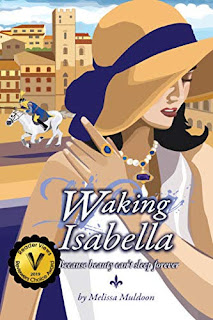Weekly Reader: Waking Isabella by Melissa Muldoon; Muldoon is At It Again With Florentine Tribute To Isabella De Medici
By Julie Sara Porter
Bookworm Reviews
Spoilers: Melissa Muldoon has given us a slightly fanciful historical fiction novel about portrait artist, Sofronisba Anguissola in The Secret Life of Sofonisba Anguissola. She has given us a journey through the centuries with portrait painter, Artemisia Gentileschi, who inspired her, and who followed in her footsteps with the novel, Eternally Artemisia. Her next volume, Waking Isabella, takes us into the life and legacy of another great woman of the Italian Renaissance. Only this time she is not so much an artist as she is a patron of the arts. In fact she is a member of one of the most famous artistic patron families in the Western world, Isabella de Medici.
Unlike the previous two books, Isabella de Medici is more talked about than shown. In fact, except for the prologue which captures Medici right at a moment of great betrayal and danger, we take no trips to the Renaissance era. Instead we are treated to two stories which use Medici as a connecting device. The first involves Nora, a jewelry designer and documentary filmmaker who is drawn to Italy and Medici herself. While filming, she falls in love with an Italian man named Luca and becomes embroiled in a mystery involving a ghost and a missing painting of Medici.
The other involves Margherita Lancini, a woman in 1941 who assists artist Frederico Donati with hiding some very valuable paintings, including Picasso's Guernica and of course a portrait of Isabella de Medici,the same one that Nora is looking for in the present.
Of the books in Muldoon's series, Waking Isabella is probably the weakest. However, it is the weakest in a very outstanding series so the weakness isn't very much. Like the others we get a brilliant look at a compelling Renaissance woman. Also since Isabella herself was not an artist, this allows the Reader to recognize that many could show their contribution to the art world even if they are not themselves artists. A patron of the arts is just as important as those that sculpt and paint.
We also see how important the Medicis were to Florentine society. Their contribution to the Renaissance was vast. They were friends and patrons of many artists, scientists, philosophers, writers, and political figures. Without the influence and guidance of the Medicis, much of what we know of the European Renaissance would have been lost.
In the brief chapters that we are shown Isabella in action, we are given a complex woman. She is filled with brilliant thoughts and a lot of passion. Despite being the Florentine equivalent of a superstar, Isabella is surrounded by enemies some because of her famous name and some by her own actions. One moment has her face to face with her soon to be assasin and she stands up to him with the wit and grace that a woman like her would possess. Isabella's brief chapter makes this Reader long for more of her.
The 1940's story is very well written as we meet Margherita and Frederico. Similar to the characters in Eternally Artemisia, these characters would preserve the arts from the flames of Nazis and Fascists even if they have to die for it. Margherita and Frederico understand that. That is how their bond is developed by sharing and appreciating the arts as well as hiding them from those who would destroy it. Despite the huge age difference, Margherita and Frederico develop a romance based on this shared interest and living in a time where emotions are at the forefront because any moment could be your last. Just like Isabella, they worked to preserve the arts so it can never be destroyed.
What isn't as interesting is the modern story. Nora is a decent enough protagonist. The Reader gets an inside view on the work it takes to make a documentary by choosing the subject, framing it in an interesting way, finding and interviewing experts on the subject, and editing the film to fit the theme. Sometimes the filmmaker has to do it with very little budget or fanfare when they are completed.
Nora's search for Isabella's painting has some suspenseful moments such as when she thinks that she sees Isabella's ghost. There are also some Nancy Drew like clues where Nora searches for the painting in secret panels and hidden compartments.
What doesn't work as well is Nora's romance with Luca. He has a familial connection with the past stories, but it's not as explored as well as it should be. He also has a secret which eats up a lot of Nora's time when she should be working on her film or studying Isabella. In fact Luca's, past struggles takes a lot of time when he is behaving unnecessarily cryptic about it. When all is revealed, the big secret is extremely underwhelming.
There is one brilliant moment where Nora and Luca meet a pair of the lovers from one of Muldoon's other books. This suggests that the books are in a shared universe in which more than one Renaissance guide is in action to help these mortals find their way in the country shaped like a boot.
While Eternally Artemisia and The Secret Life of Sofonisba Anguissola are much better, Waking Isabella is also a brilliant tribute to the women of the Renaissance and how their legacy can still be felt today.

No comments:
Post a Comment